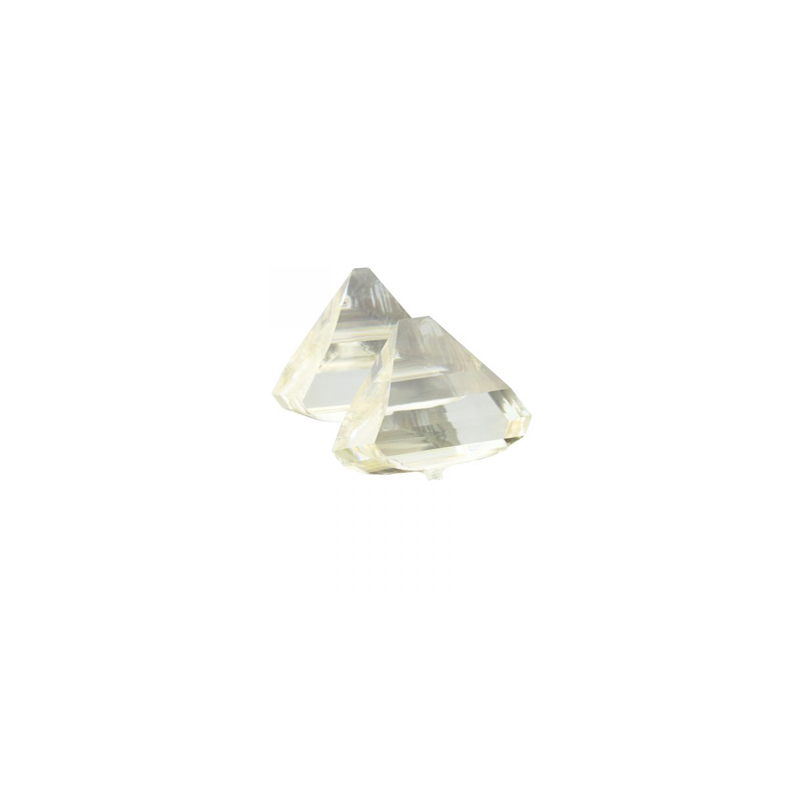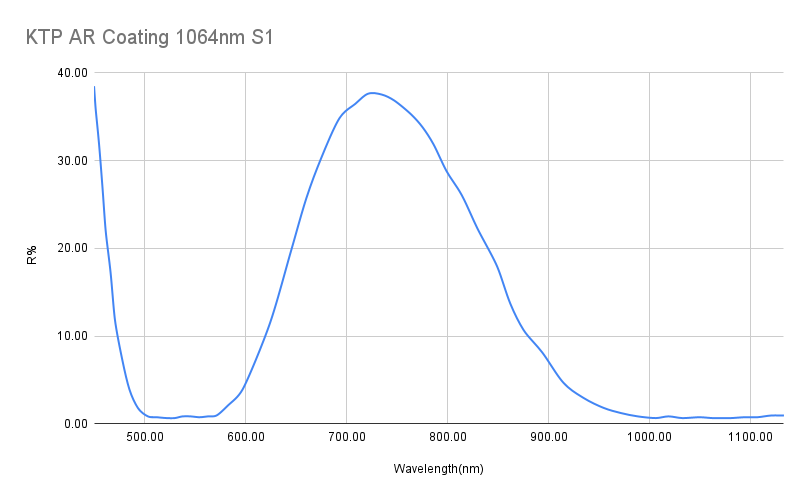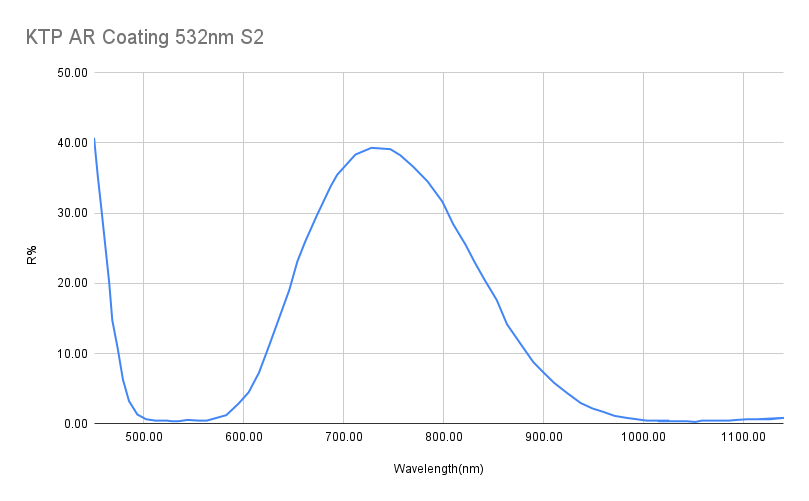KTP Crystal
A KTP crystal can be used for various applications such as laser surgery, skin treatments, laser pointers, RGB displays, and tunable sources for the visible to mid-infrared range. It can also be used for electro-optic devices such as Q-switches and modulators
- KTP crystal is an inorganic compound with the formula KTiOPO4 that is commonly used for frequency-doubling diode-pumped solid-state lasers such as Nd:YAG and other neodymium-doped laser.
- KTP crystal has large nonlinear optical coefficients, wide angular bandwidth and small walk-off angle, broad temperature and spectral bandwidth, nonhydroscopic, chemically and mechanically stable, high thermal conductivity, and extremely low cost compared to KTA, BBO and LBO.
- KTP crystal can be used for frequency doubling (SHG) or sum frequency mixing (SFG) to generate Red/Green/Blue (RGB) outputs, and for optical parameteric oscillator (OPO) or optical parametric amplifier (OPA) to generate visible to mid-infrared tunable wavelengths. KTP crystal is also used in many electro-optic (E-O) devices such as Q-switches and E-O modulators.
- KTP crystal has a high threshold to optical damage (~15 J/cm²), an excellent optical nonlinearity and excellent thermal stability in theory. However, it is prone to photochromic damage (called grey tracking) during high-power 1064 nm second-harmonic generation which tends to limit its use to low- and mid-power systems.
- KTP crystal is highly transparent for wavelengths between 350–2700 nm with a reduced transmission out to 4500 nm where the crystal is effectively opaque. Its second-harmonic generation (SHG) coefficient is about three times higher than KDP. It has a Mohs hardness of about 5.

Sample KTP Crystal
- Dimension : 6.5*6.5*6.0mm
- Theta=90Deg,Phi=23.5Deg
- AR/AR Coating : 1064nm(R<0.2%) & 532nm(R<0.5%)
What is a KTP Crystal?
A KTP crystal is an inorganic compound with the formula KTiOPO4. It is a white solid that has a large nonlinear optical coefficient, a wide angular bandwidth and a small walk-off angle, a broad temperature and spectral bandwidth, and a high thermal conductivity.
A KTP crystal works by exploiting its nonlinear optical properties to convert one wavelength of light into another through processes such as frequency doubling (SHG), sum frequency mixing (SFG), or optical parametric oscillation (OPO). For example, a KTP crystal can be used to double the frequency of a 1064 nm Nd:YAG laser to produce a 532 nm green output.
| Property | Value |
|---|---|
| Chemical formula | KTiOPO4 |
| Density | 3.026 g/cm3 |
| Transparency range | 350-4500 nm |
| SHG coefficient | 3 times higher than KDP |
| Damage threshold | ~15 J/cm2 |
| Mohs hardness | ~5 |
| Application examples | SHG/SFG/OPO of Nd:YAG and other neodymium-doped lasers, laser surgery, skin treatments, laser pointers, RGB displays, Q-switches, modulators |
Specification & Products
| wdt_ID | SKU | Phi & Theta | Type | Size(mm) | Coating | Application |
|---|---|---|---|---|---|---|
| 1 | HTKTP.001 | 23.5 + 90 | SHG TYPE II | 6x6x3 | AR1064&532 | SHG of 1064 nm, type II |
| 2 | HTKTP.002 | 23.5 + 90 | SHG TYPE II | 6x6x5 | AR1064&532 | SHG of 1064 nm, type II |
| 3 | HTKTP.003 | 23.5 + 90 | SHG TYPE II | 7x7x5 | AR1064&532 | SHG of 1064 nm, type II |
| 4 | HTKTP.004 | 23.5 + 90 | SHG TYPE II | 8x8x5 | AR1064&532 | SHG of 1064 nm, type II |
| 5 | HTKTP.005 | 23.5 + 90 | SHG TYPE II | 9x9x5 | AR1064&532 | SHG of 1064 nm, type II |
| 6 | HTKTP.006 | 23.5 + 90 | SHG TYPE II | 15x15x6 | AR1064&532 | SHG of 1064 nm, type II |
| 7 | HTKTP.007 | 0 + 90 | OPO | 4x4x20 | AR1570&1064 | OPO @ 1064 nm -> 1570 nm + 3300 nm |
| 8 | HTKTP.008 | 0 + 90 | OPO | 6x6x20 | AR1570&1064 | OPO @ 1064 nm -> 1570 nm + 3300 nm |
| 9 | HTKTP.009 | 0 + 90 | OPO | 7x7x20 | AR1570&1064 | OPO @ 1064 nm -> 1570 nm + 3300 nm |
| wdt_ID | Attributes | Values |
|---|---|---|
| 15 | Dimension Tolerance | W(+/-0.1)*H(+/-0.1)*L(+0.5/-0.1)mm |
| 16 | Surface Quality | 20/10 Scratch and Dig |
| 27 | Surface Flatness | <λ/8 at 633 nm |
| 28 | Wavefront Distortion | <λ/4 at 633nm |
| 29 | Parallelism | <20 arc seconds |
| 30 | Perpendicularity | <5 arc minuntes |
| 31 | Clear Aperture | >Central 90% |
| 32 | AR-Coating | dual waveband AR coating at 1064/532 nm on both surfaces, with R<0.2% at 1064 nm and R<0.5% at 0.532 nm per surface |
| wdt_ID | Attributes | Values |
|---|---|---|
| 47 | Crystal Structure | Orthorhombic, space group Pna2₁,point group mm² |
| 48 | Lattice Parameter | a=6.404Å, b=10.616Å, c=12.814A, Z=8 |
| 49 | Melting point | About 1172℃ |
| 50 | Mohs hardness | 5 |
| 51 | Density | 3.01g/cm³ |
| 52 | Thermal Conductivity coefficient | 13W/m/K |
| 53 | Thermal Expansion Coefficient | aₓ=11x10⁻⁶/℃, aᵧ=9x10⁻⁶/℃, az=0.6x10⁻⁶/℃ |
| 54 | Transparency Range | 350~4500nm |
| 55 | SHG Phase Matchable Range | 497~1800nm (Type Ⅱ) |
| 56 | Thermal-optic Coefficients(/°C) | dnx/dT=1.1x10⁻⁵ dnᵧ/dT=1.3x10⁻⁵ dnz/dT=1.6x10⁻⁵ |
| 57 | Absorption Coefficients | <0.1%/cm at 1064nm <1%/cm at 532nm |
| 58 | For TypeⅡ SHG of a Nd:YAG laser at 1064nm | Temperature Acceptance: 24℃•cm Spectral Acceptance: 0.56nm•cm Angular Acceptance: 14.2mrad•cm(φ); 55.3mrad•cm(θ) |
| 59 | NLO coefficients | deff (Ⅱ)≈(d₂₄-d₁₅)sin2φsin2θ-(d₁₅sin²φ+d₂₄cos²φ)sinθ |
| 60 | Non-vanished NLO Susceptibilities | d₃₁=6.5pm/V d₂₄=7.6pm/V d₃₂=5 pm/V d₁₅=6.1pm/V d₃₃=13.7pm/V |
| 61 | Electro-optic Coefficients | Low frequency(pm/V) High frequency(pm/V) |
Coatings for KTP crystals
coating for KTP crystal is important to reduce the reflection losses and increase the transmission efficiency of the crystal. The type of coating depends on the application and the wavelength of the laser.
For example, for SHG of 1064 nm, the standard coating is dual band AR (DBAR) at 1064/532 nm. This coating allows the input beam at 1064 nm to enter the crystal with minimal loss, and the output beam at 532 nm to exit the crystal with high transmission.
 |
 |
Another example is HR @ 1064 nm and HT @ 532 nm coating, which is used for compact laser-SHG devices. This coating reflects the input beam at 1064 nm back into the laser cavity, and transmits the output beam at 532 nm out of the crystal. This coating enhances the intracavity power and improves the SHG efficiency.
A third example is AR/AR@1064+1570+3300 nm coating, which is used for eye safe generation by OPO @ 1064 nm -> 1570 nm + 3300 nm. This coating reduces the reflection losses for both the pump beam at 1064 nm and the signal and idler beams at 1570 nm and 3300 nm, respectively. This coating increases the OPO conversion efficiency and output power.
KTP Laser Setup Example

- The laser diode is a device that emits a laser beam with a wavelength of 808 nm (infrared) and a power of 2 W. The laser diode is used as a pump source for the Nd:YVO4 crystal, which is a laser gain medium that can amplify light at 1064 nm (infrared).
- The collimating lens is an optical component that converts the diverging beam from the laser diode into a parallel beam. The collimating lens is used to improve the beam quality and reduce the beam divergence.
- The Nd:YVO4 crystal is a laser gain medium that can absorb light at 808 nm and emit light at 1064 nm through a process called stimulated emission. The Nd:YVO4 crystal is cut and oriented in such a way that it satisfies the polarization condition for efficient lasing. The Nd:YVO4 crystal is also temperature-stabilized by a thermoelectric cooler (TEC) to maintain its optimal performance.
- The KTP crystal is a nonlinear optical material that can convert the frequency of light. The KTP crystal is cut and oriented in such a way that it satisfies the phase matching condition for second harmonic generation (SHG), which means that two photons of the input beam can combine to produce one photon of twice the frequency (or half the wavelength) at 532 nm (green). This process is also called frequency doubling. The KTP crystal is also temperature-stabilized by a thermoelectric cooler (TEC) to maintain its optimal performance.
- The output coupler is an optical component that partially reflects and partially transmits light. The output coupler is used to form a resonant cavity with the Nd:YVO4 crystal, which enhances the stimulated emission process and increases the output power. The output coupler also allows some of the light to exit the cavity as the output beam.
- The dichroic mirror is an optical component that reflects light of one wavelength and transmits light of another wavelength. The dichroic mirror is used to separate the infrared beam from the green beam, which are both generated inside the cavity. The dichroic mirror reflects the green beam and transmits the infrared beam.
- The output beam from the dichroic mirror contains only the green beam, which has a wavelength of 532 nm and a power of 300 mW. The output beam can be used for various applications such as laser displays, medical lasers, or spectroscopy.
